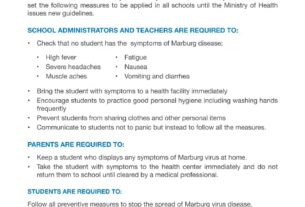Rwanda and the World Health Organization( WHO) officially declared the end of the Marburg fever outbreak in the country on Friday, following a period of no new cases in recent weeks. The advertisement marks the conclusion of an violent public health challenge that began in late September.
The outbreak, first linked on September 27, saw a aggregate of 66 verified cases and 15 deaths. The maturity of those infected were healthcare workers who had been in close contact with the original cases. Marburg, a largely contagious and deadly contagion analogous to Ebola, has a casualty rate that can reach up to 88 without proper medical intervention.
Marburg contagion complaint is caused by a zoonotic pathogen, meaning it’s transmitted from creatures to humans. Fruit batons are considered the natural hosts of the contagion, and mortal outbreaks frequently begin when individualities come into contact with club colonies in grottoes or mines. The complaint also spreads through mortal- to- mortal transmission, primarily via direct contact with fleshly fluids similar as blood, slaver, and sweat. defiled shells and accoutrements , including medical outfit, can also grease transmission, making healthcare settings particularly vulnerable.
Symptoms of Marburg include fever, muscle pain, diarrhea, puking, and in severe cases, gushing bleeding that can lead to death. There’s no approved vaccine or specific treatment for the complaint, though Rwanda entered a force of experimental vaccine boluses in October, which may have played a part in controlling the spread. probative care, similar as rehydration and treatment of specific symptoms, is presently the most effective way to ameliorate survival rates.

According to the WHO’s guidelines, an outbreak is officially declared over after two complete 21- day incubation ages — a aggregate of 42 days — without new cases. This corner was achieved when the last case was discharged on November 8, and no new verified cases were reported since October 30. The successful constraint of the outbreak demonstrates the efficacity of Rwanda’s public health measures, including contact dogging, insulation, and community engagement.
The nippy identification and insulation of cases played a pivotal part in precluding farther spread. Upon the evidence of the first case, Rwanda’s Ministry of Health fleetly mustered healthcare brigades, equipped treatment centers, and initiated a public mindfulness crusade to educate communities about the symptoms and forestallment of Marburg. These sweats were rounded by transnational support, with the WHO and other global health associations furnishing moxie, backing, and coffers.
One of the most critical aspects of the response was the protection of healthcare workers, who are frequently at the topmost threat during outbreaks of viral hemorrhagic complications. particular defensive outfit( PPE) was distributed extensively, and healthcare professionals entered technical training in infection forestallment and control( IPC) measures. The collaboration between original health authorities and transnational mates assured that the response was both nippy and effective, limiting the outbreak’s impact.
Sabin Nzanzimana, Rwanda’s Minister of Health, stressed the significance of community involvement in combating the outbreak.” The success in ending this outbreak is n’t just the result of government conduct but also the adaptability and cooperation of our communities. They played a vital part in reporting symptoms, clinging to forestallment measures, and supporting healthcare workers,” he said during a press briefing. The minister also noted that public health education sweats will continue to insure communities remain watchful.

While the sanctioned protestation of the outbreak’s end is a significant relief, both WHO officers and Dr. Nzanzimana emphasized that alert is still necessary. The threat of farther cases remains, and ongoing monitoring will be pivotal to insure that any implicit rejuvenescence is fleetly addressed. The WHO has advised that while the Marburg contagion is fairly rare, its high casualty rate and eventuality for rapid-fire spread make it a global health trouble.
This protestation is a testament to the nippy response and collaboration between Rwanda’s health authorities and the global health community, showcasing the significance of coordinated sweats in managing arising contagious conditions. The assignments learned from this outbreak will really inform unborn responses to analogous public health challenges.
The outbreak also underlined the significance of exploration and invention in combating contagious conditions. The experimental vaccines handed during the extremity were part of ongoing global sweats to develop effective countermeasures against the Marburg contagion. While these vaccines are still in the trial phase, their deployment in Rwanda offers precious data that could accelerate their development and eventual blessing. Experts have called for increased investment in vaccine exploration to more prepare for unborn outbreaks.
In addition to vaccines, advancements in individual tools played a significant part in controlling the outbreak. Rapid individual tests were used to snappily identify cases, enabling timely insulation and treatment. These tools, combined with robust contact tracing sweats, assured that implicit chains of transmission were intruded before they could escalate. The integration of technology and data analytics into the public health response further enhanced its effectiveness.
Looking ahead, Rwanda plans to strengthen its healthcare system to more prepare for unborn outbreaks. The government has outlined plans to invest in structure, train fresh healthcare workers, and expand access to essential medical inventories. These measures are aimed at erecting a more flexible health system able of responding to a wide range of public health pitfalls.


The transnational community has also taken note of Rwanda’s successful running of the outbreak. Dr. Matshidiso Moeti, WHO Regional Director for Africa, praised Rwanda’s response as a model for other countries facing analogous challenges.” Rwanda’s experience demonstrates that with strong leadership, community engagement, and transnational support, indeed the most severe outbreaks can be contained,” she said. Dr. Moeti also emphasized the need for continued global solidarity in addressing contagious conditions, particularly in low- and middle- income countries that may warrant the coffers to respond effectively on their own.
The Marburg outbreak in Rwanda has also reignited conversations about global health security and the significance of preparedness. Experts have called for increased backing for enterprise similar as the WHO’s Health extremities Programme, which aims to strengthen the capacity of countries to help, descry, and respond to health extremities. They argue that investing in preparedness is n’t only a moral imperative but also a cost-effective strategy, as it reduces the profitable and social impact of outbreaks.
likewise, the outbreak has stressed the part of public trust in managing health heads. In numerous corridor of the world, misinformation and mistrust of health authorities can hamper response sweats, leading to dragged outbreaks and advanced mortality rates. Rwanda’s success in fostering community trust and icing transparent communication offers precious assignments for other countries. Clear, harmonious messaging and active community engagement were crucial factors in encouraging individualities to report symptoms, seek care, and cleave to forestallment measures.
As the world reflects on Rwanda’s experience, it’s clear that combating contagious conditions requires a multifaceted approach. This includes strengthening health systems, investing in exploration and invention, fostering transnational collaboration, and prioritizing community engagement. The Marburg outbreak may have been a severe test of Rwanda’s public health capacity, but it also showcased the country’s adaptability and capability to rise to the challenge.
In conclusion, the protestation of the end of the Marburg outbreak in Rwanda is a significant corner that underscores the significance of preparedness, collaboration, and community involvement in addressing public health heads. While the immediate trouble has passed, the experience serves as a memorial of the ongoing need to invest in health security and strengthen global sweats to combat arising contagious conditions. By erecting on the assignments learned from this outbreak, Rwanda and the transnational community can more cover populations from unborn health pitfalls.



